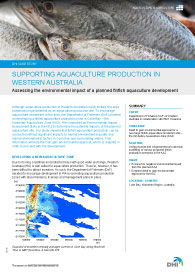
Due to its long coastlines and protected bays with good water exchange, Western Australia (WA) is well suited for aquaculture production. The Department of Fisheries (DoF) wanted to encourage development in WA by providing aquaculture production zones with all permissions, licenses and management plans in place.
The DoF identified a feasible development site in Cone Bay in Australia’s Kimberley region – the Kimberley Aquaculture Zone (KAZ). It is particularly well suited for Barramundi (a type of finfish) – a valuable brand, especially for the high end seafood restaurants in Australia.
Before the KAZ could be developed, the DoF needed to gain approval for this large potential finfish production site in what is considered a pristine marine environment. To ensure that the impacts of the finfish farms would be minimal, we utilised our numerical models and our strong understanding of the drivers of oceanographic and benthic processes in the region to conduct an environmental impact assessment (EIA).
Using an integrated modelling approach, we coupled physical modelling with biogeochemical numerical modelling of various proposed scenarios. This included developing hydrodynamic, deposition, ecological and habitat models. Working in partnership with BMT Oceanica, we utilised the extensive field data they collected to describe baseline conditions. This data also provided the required input data for our models.
We then assessed the potential impact from major pressures (nutrients and organic debris) on the most important marine ecological components (including fauna and corals) in Cone Bay. Next, we ran a number of different scenarios with varying production volume feed conversion rates, stocking densities, and positions of production cages. Our study confirmed that:
- the site selected by the DoF is suitable for the planned aquaculture development
- the proposed aquaculture zones will have minimal impacts on the surrounding ecosystem
This information was crucial for the DoF in obtaining environmental approval for their new aquaculture development.